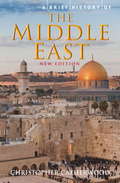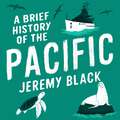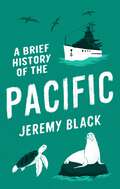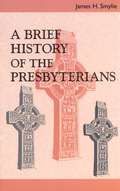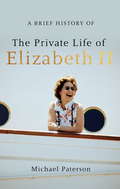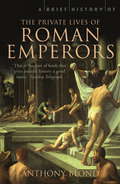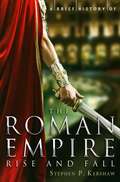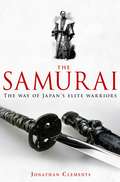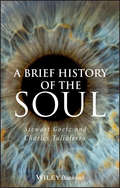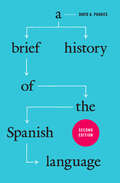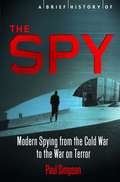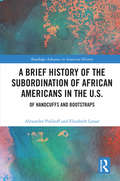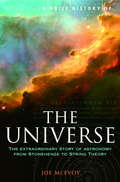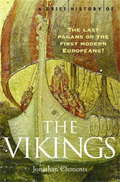- Table View
- List View
A Brief History of the Middle East: From Abraham To Arafat (Brief Histories )
by Christopher CatherwoodWestern civilization began in the Middle East: Judaism and Christianity, as well as Islam, were born there. For over a millennium, the Islamic empires were ahead of the West in learning, technology and medicine, and were militarily far more powerful. It took another three hundred centuries for the West to catch up, and overtake, the Middle East.Why does it seem different now? Why does Osama bin Laden see 1918, with the fall of the Ottoman Empire, as the year everything changed? These issues are explained in historical detail here, in a way that deliberately seeks to go behind the rhetoric to the roots of present conflicts. A Brief History of the Middle East is essential reading for an intelligent reader wanting to understand what one of the world's key regions is all about. Fully updated with a new section on the Iraq Invasion of 2003, the question of Iran and the full context of the Isreali/Palestine conflict.
A Brief History of the Pacific: The Great Ocean (Brief Histories)
by Jeremy BlackThis brilliantly concise history of the Pacific Ocean nevertheless succeeds in examining both the indigenous presence on ocean's islands and Western control or influence over the its islands and shores. There is a particular focus on the period from the 1530s to 1890 with its greater Western coastal and oceanic presence in the Pacific, beginning with the Spanish takeover of the coasts of modern Central America, Colombia, Ecuador and Peru, and continuing with the Spaniards in the Philippines. There is also an emphasis on the very different physical and human environments of the four quadrants of the Pacific - the north-east, the north-west, the south-east and the south-west - and of the 'coastal' islands, that is the Aleutians, Japan and New Zealand, and continental coastlines. The focus is always on the interactions of Japan, California, Peru, Australia and other territories with the ocean, notably in terms of trade, migration and fishing.Black looks first at the geology, currents, winds and physical make-up of the Pacific, then the region's indigenous inhabitants to 1520. He describes the Pacific before the arrival of Europeans, its history of settlement, navigation methods and religious practices.From Easter Island, the focus shifts to European voyages, from Magellan to Cook and Tasman, the problems they faced, not least the sheer scale of the ocean. Black looks at the impact of these voyages on local people, including the Russians in the Aleutian Islands. Outside control of the region grew from 1788 to 1898. The British laid claim to Australia and America to the Phillipines. Western economic and political impact manifested in sandalwood and gold rushes, and the coming of steamships accelerated this impact. Territorial claims spread through Willis, Perry and the Americans, including to Hawaii. Black looks at the Maori wars in New Zealand and the War of the Pacific on the South American coast. Christian missionary activity increased, and Gaugin offered a different vision of the Pacific. 1899 to 1945 marked the struggle of empires: the rise of Japan as an oceanic power, and the Second World War in the Pacific as a critical moment in world history. Oil-powered ships ushered in the American Age, from 1945 to 2015, bringing the end of the British Pacific. France had a continued role, in Tahiti and New Caledonia, but America had become the dominant presence. Black explores the political, economic and cultural impacts of, for example, Polynesians attending universities in America and Australasia; the spread of rugby; and relatively little international tension, although some domestic pressures remained, including instability in Papua New Guinea and Fiji. The book ends with a look at the Pacific's future: pressures from industrial fishing, pollution and climate change; the rise of drug smuggling; greater Chinese influence leading to conflict with America and Australasia - the Pacific is once again on the frontline of military planning. But the Pacific's future also includes tourism, from Acapulco to Hawaii, and from Tahiti to Cairns.
A Brief History of the Pacific: The Great Ocean (Brief Histories)
by Jeremy BlackThis brilliantly concise history of the Pacific Ocean nevertheless succeeds in examining both the indigenous presence on ocean's islands and Western control or influence over the its islands and shores. There is a particular focus on the period from the 1530s to 1890 with its greater Western coastal and oceanic presence in the Pacific, beginning with the Spanish takeover of the coasts of modern Central America, Colombia, Ecuador and Peru, and continuing with the Spaniards in the Philippines. There is also an emphasis on the very different physical and human environments of the four quadrants of the Pacific - the north-east, the north-west, the south-east and the south-west - and of the 'coastal' islands, that is the Aleutians, Japan and New Zealand, and continental coastlines. The focus is always on the interactions of Japan, California, Peru, Australia and other territories with the ocean, notably in terms of trade, migration and fishing.Black looks first at the geology, currents, winds and physical make-up of the Pacific, then the region's indigenous inhabitants to 1520. He describes the Pacific before the arrival of Europeans, its history of settlement, navigation methods and religious practices.From Easter Island, the focus shifts to European voyages, from Magellan to Cook and Tasman, the problems they faced, not least the sheer scale of the ocean. Black looks at the impact of these voyages on local people, including the Russians in the Aleutian Islands. Outside control of the region grew from 1788 to 1898. The British laid claim to Australia and America to the Phillipines. Western economic and political impact manifested in sandalwood and gold rushes, and the coming of steamships accelerated this impact. Territorial claims spread through Willis, Perry and the Americans, including to Hawaii. Black looks at the Maori wars in New Zealand and the War of the Pacific on the South American coast. Christian missionary activity increased, and Gaugin offered a different vision of the Pacific. 1899 to 1945 marked the struggle of empires: the rise of Japan as an oceanic power, and the Second World War in the Pacific as a critical moment in world history. Oil-powered ships ushered in the American Age, from 1945 to 2015, bringing the end of the British Pacific. France had a continued role, in Tahiti and New Caledonia, but America had become the dominant presence. Black explores the political, economic and cultural impacts of, for example, Polynesians attending universities in America and Australasia; the spread of rugby; and relatively little international tension, although some domestic pressures remained, including instability in Papua New Guinea and Fiji. The book ends with a look at the Pacific's future: pressures from industrial fishing, pollution and climate change; the rise of drug smuggling; greater Chinese influence leading to conflict with America and Australasia - the Pacific is once again on the frontline of military planning. But the Pacific's future also includes tourism, from Acapulco to Hawaii, and from Tahiti to Cairns.
A Brief History of the Pacific: The Great Ocean (Brief Histories)
by Jeremy BlackThis brilliantly concise history of the Pacific Ocean nevertheless succeeds in examining both the indigenous presence on ocean's islands and Western control or influence over the its islands and shores. There is a particular focus on the period from the 1530s to 1890 with its greater Western coastal and oceanic presence in the Pacific, beginning with the Spanish takeover of the coasts of modern Central America, Colombia, Ecuador and Peru, and continuing with the Spaniards in the Philippines. There is also an emphasis on the very different physical and human environments of the four quadrants of the Pacific - the north-east, the north-west, the south-east and the south-west - and of the 'coastal' islands, that is the Aleutians, Japan and New Zealand, and continental coastlines. The focus is always on the interactions of Japan, California, Peru, Australia and other territories with the ocean, notably in terms of trade, migration and fishing.Black looks first at the geology, currents, winds and physical make-up of the Pacific, then the region's indigenous inhabitants to 1520. He describes the Pacific before the arrival of Europeans, its history of settlement, navigation methods and religious practices.From Easter Island, the focus shifts to European voyages, from Magellan to Cook and Tasman, the problems they faced, not least the sheer scale of the ocean. Black looks at the impact of these voyages on local people, including the Russians in the Aleutian Islands. Outside control of the region grew from 1788 to 1898. The British laid claim to Australia and America to the Phillipines. Western economic and political impact manifested in sandalwood and gold rushes, and the coming of steamships accelerated this impact. Territorial claims spread through Willis, Perry and the Americans, including to Hawaii. Black looks at the Maori wars in New Zealand and the War of the Pacific on the South American coast. Christian missionary activity increased, and Gaugin offered a different vision of the Pacific. 1899 to 1945 marked the struggle of empires: the rise of Japan as an oceanic power, and the Second World War in the Pacific as a critical moment in world history. Oil-powered ships ushered in the American Age, from 1945 to 2015, bringing the end of the British Pacific. France had a continued role, in Tahiti and New Caledonia, but America had become the dominant presence. Black explores the political, economic and cultural impacts of, for example, Polynesians attending universities in America and Australasia; the spread of rugby; and relatively little international tension, although some domestic pressures remained, including instability in Papua New Guinea and Fiji. The book ends with a look at the Pacific's future: pressures from industrial fishing, pollution and climate change; the rise of drug smuggling; greater Chinese influence leading to conflict with America and Australasia - the Pacific is once again on the frontline of military planning. But the Pacific's future also includes tourism, from Acapulco to Hawaii, and from Tahiti to Cairns.
A Brief History of the Presbyterians
by James H. SmylieA Brief History of the Presbyterians offers laity and clergy a succinct and thorough introduction to the history of Presbyterianism. James Smylie reaches into the past and vividly recounts the story of a faithful people known as Presbyterians. He chronicles the origins of the Reformed tradition and carries the saga through each subsequent era up to the eve of the twenty-first century, focusing on Presbyterianism in North America. All the major figures in the history of Presbyterianism such as John Calvin, Francis Makemie, and John Witherspoon are included, as well as a host of others. Smylie provides a fresh look at the uniquely Presbyterian contribution to American history and culture. Contemporary insights from ecumenists, laity, women, and minorities that reflect recent changes in the Presbyterian family are included.
A Brief History of the Private Life of Elizabeth II
by Michael PatersonElizabeth II is within a few years of becoming the longest-reigning British monarch. A personally quiet, modest and dutiful person, she is far better-informed about the lives of her subjects than they often realize. She has known every Prime Minister since Winston Churchill and every American President since Eisenhower.Yet what of the woman behind the crown?The book seeks to take a new look at this exhaustively-documented life and show how Queen Elizabeth became the person she is. Who, and what, have been the greatest influences upon her? What are her likes and dislikes? What are her hobbies? Who are her friends? What does she feel about the demands of duty and protocol? Is she really enjoying herself when she smiles during official events? How differently does she behave when out of the public eye? Examining the places in which she grew up or has lived, the training she received and her attitudes to significant events in national life, it presents a fresh view of one of recent history's most important figures.
A Brief History of the Private Life of Elizabeth II (Brief Histories)
by Michael PatersonElizabeth II is the longest-reigning British monarch. A personally quiet, modest and dutiful person, she is far better-informed about the lives of her subjects than they often realize. She has known every Prime Minister since Winston Churchill and every American President since Eisenhower. Yet what of the woman behind the crown?This book seeks to take a new look at this exhaustively-documented life and show how Queen Elizabeth became the person she is. Who, and what, have been the greatest influences upon her? What are her likes and dislikes? What are her hobbies? Who are her friends? What does she feel about the demands of duty and protocol? Is she really enjoying herself when she smiles during official events? How differently does she behave when out of the public eye? Examining the places in which she grew up or has lived, the training she received and her attitudes to significant events in national life, it presents a fresh view of one of recent history's most important figures.In recent years, Queen Elizabeth has become the longest-reigning monarch in our history and has cut back on commitments. Nevertheless she is still very active and has made some wise decisions about who takes over a number of her duties.
A Brief History of the Private Lives of the Roman Emperors
by Anthony BlondWith the recent success of 'Rome' on BBC2, no one will look at the private lives of the Roman Emperors again in the same light. Anthony Blond's scandalous expose of the life of the Caesars is a must-read for all interested in what really went on in ancient Rome. Julius Caesar is usually presented as a glorious general when in fact he was an arrogant charmer and a swank; Augustus was so conscious of his height that he put lifts in his sandals.But they were nothing compared to Caligula, Claudius and Nero. This book is fascinating reading, eye-opening in its revelations and effortlessly entertaining.
A Brief History of the Private Lives of the Roman Emperors (Brief Histories)
by Anthony BlondWith the recent success of 'Rome' on BBC2, no one will look at the private lives of the Roman Emperors again in the same light. Anthony Blond's scandalous expose of the life of the Caesars is a must-read for all interested in what really went on in ancient Rome. Julius Caesar is usually presented as a glorious general when in fact he was an arrogant charmer and a swank; Augustus was so conscious of his height that he put lifts in his sandals.But they were nothing compared to Caligula, Claudius and Nero. This book is fascinating reading, eye-opening in its revelations and effortlessly entertaining.
A Brief History of the Relationship Between Confucianism, Daoism, and Buddhism
by Zhongjian MouChinese traditions of Confucianism, Daoism, and Buddhism have a profoundly philosophical dimension. The three traditions are frequently referred to as three paths of moral teachings. In this book, Mou provides a clear account of the textual corpus that emerges to define each of these traditions and how this canonical axis was augmented by a continuing commentarial tradition as each generation reauthorized the written core for their own time and place. In his careful exegesis, Mou lays out the differences between the more religious reading of these traditions with their defining practices that punctuate the human journey through life, and the more intellectual and philosophical treatment of the texts that has and continues to produce a first-order culture of annotation that become integral to the traditions themselves. At the center of the alternative religious experience reflected throughout the teachings of Confucianism, Daoism, and Buddhism is the project of personal cultivation as it comes to be expressed as robust growth in family and communal relations. For Mou, these three highly distinctive and yet complementary ways of thinking and living constitute a kind of moral ecology, wherein each of them complements the others as they stand in service to a different dimension of the human need for an educated spirituality.
A Brief History of the Roman Empire (Brief Histories )
by Stephen KershawIn this lively and very readable history of the Roman Empire from its establishment in 27 BC to the barbarian incursions and the fall of Rome in AD 476, Kershaw draws on a range of evidence, from Juvenal's Satires to recent archaeological finds. He examines extraordinary personalities such as Caligula and Nero and seismic events such as the conquest of Britain and the establishment of a 'New Rome' at Constantinople and the split into eastern and western empires. Along the way we encounter gladiators and charioteers, senators and slaves, fascinating women, bizarre sexual practices and grotesque acts of brutality, often seen through eyes of some of the world's greatest writers. He concludes with a brief look at how Rome lives on in the contemporary world, in politics, architecture, art and literature.
A Brief History of the Roman Empire (Brief Histories)
by Dr Stephen P. KershawIn this lively and very readable history of the Roman Empire from its establishment in 27 BC to the barbarian incursions and the fall of Rome in AD 476, Kershaw draws on a range of evidence, from Juvenal's Satires to recent archaeological finds. He examines extraordinary personalities such as Caligula and Nero and seismic events such as the conquest of Britain and the establishment of a 'New Rome' at Constantinople and the split into eastern and western empires. Along the way we encounter gladiators and charioteers, senators and slaves, fascinating women, bizarre sexual practices and grotesque acts of brutality, often seen through eyes of some of the world's greatest writers. He concludes with a brief look at how Rome lives on in the contemporary world, in politics, architecture, art and literature.
A Brief History of the Samurai (Brief Histories)
by Jonathan Clements'Clements has a knack for writing suspenseful sure-footed conflict scenes: His recounting of the Korean invasion led by samurai and daimyo Toyotomi Hideyoshi reads like a thriller. If you're looking for a samurai primer, Clements' guide will keep you on the hook' Japan Times, reviewed as part of an Essential Reading for Japanophiles series From a leading expert in Japanese history, this is one of the first full histories of the art and culture of the Samurai warrior. The Samurai emerged as a warrior caste in Medieval Japan and would have a powerful influence on the history and culture of the country from the next 500 years. Clements also looks at the Samurai wars that tore Japan apart in the 17th and 18th centuries and how the caste was finally demolished in the advent of the mechanized world.
A Brief History of the Samurai: The Way of Japan's Elite Warriors (Brief History )
by Jonathan ClementsFrom a leading expert in Japanese history, this is one of the first full histories of the art and culture of the Samurai warrior. <P><P>The Samurai emerged as a warrior caste in Medieval Japan and would have a powerful influence on the history and culture of the country from the next 500 years. Clements also looks at the Samurai wars that tore Japan apart in the 17th and 18th centuries and how the caste was finally demolished in the advent of the mechanized world.
A Brief History of the Soul
by Charles Taliaferro Stewart GoetzThis book is a clear and concise history of the soul in western philosophy, from Plato to cutting-edge contemporary work in philosophy of mind. Packed with arguments for and against a range of different, historically significant philosophies of the soulAddresses the essential issues, including mind-body interaction, the causal closure of the physical world, and the philosophical implications of the brain sciences for the soul's existence Includes coverage of theories from key figures, such as Plato, Aquinas, Locke, Hume, and DescartesUnique in combining the history of ideas and the development of a powerful case for a non-reductionist, non-materialist account of the soul
A Brief History of the Spanish Language
by David A. PhariesSince its publication in 2007, A Brief History of the Spanish Language has become the leading introduction to the history of one of the world's most widely spoken languages. Moving from the language's Latin roots to its present-day forms, this concise book offers readers insights into the origin and evolution of Spanish, the historical and cultural changes that shaped it, and its spread around the world. A Brief History of the Spanish Language focuses on the most important aspects of the development of the Spanish language, eschewing technical jargon in favor of straightforward explanations. Along the way, it answers many of the common questions that puzzle native speakers and non-native speakers alike, such as: Why do some regions use tú while others use vos? How did the th sound develop in Castilian? And why is it la mesa but el agua? David A. Pharies, a world-renowned expert on the history and development of Spanish, has updated this edition with new research on all aspects of the evolution of Spanish and current demographic information. This book is perfect for anyone with a basic understanding of Spanish and a desire to further explore its roots. It also provides an ideal foundation for further study in any area of historical Spanish linguistics and early Spanish literature. A Brief History of the Spanish Language is a grand journey of discovery, revealing in a beautifully compact format the fascinating story of the language in both Spain and Spanish America.
A Brief History of the Spy: Modern Spying From The Cold War To The War On Terror (Brief Histories )
by Paul SimpsonFrom the end of the Second World War to the present day, the world has changed immeasurably. The art of spying has changed too, as spies have reacted to changing threats. Here you will find the fascinating stories of real-life spies, both famous and obscure, from either side of the Iron Curtain, along with previously secret details of War on Terror operations.Detailed stories of individual spies are set in the context of the development of the major espionage agencies, interspersed with anecdotes of gadgets, trickery, honeytraps and assassinations worthy of any fictional spy.A closing section examines the developing New Cold War, as Russia and the West confront each other once again.
A Brief History of the Spy: Modern Spying from the Cold War to the War on Terror (Brief Histories)
by Paul SimpsonFrom the end of the Second World War to the present day, the world has changed immeasurably. The art of spying has changed too, as spies have reacted to changing threats. Here you will find the fascinating stories of real-life spies, both famous and obscure, from either side of the Iron Curtain, along with previously secret details of War on Terror operations.Detailed stories of individual spies are set in the context of the development of the major espionage agencies, interspersed with anecdotes of gadgets, trickery, honeytraps and assassinations worthy of any fictional spy.A closing section examines the developing New Cold War, as Russia and the West confront each other once again.
A Brief History of the Subordination of African Americans in the U.S.: Of Handcuffs and Bootstraps (Routledge Advances in American History #15)
by Alexander Polikoff Elizabeth LassarThis "brief history" presents the essential story of the subordination of African Americans in the U.S., captured in a 1968 cartoon by Pulitzer-prize-winning cartoonist John Fischetti. The drawing is of a black man handcuffed to a wall with cuffs labeled "White Racism." The caption reads, "Why don’t they lift themselves up by their own bootstraps like we did?" Bootstraps shows just how little lift-up there has been, and how the handcuffs of white racism have been and continue to be the cause. Unique in its combination of comprehensiveness and brevity, Bootstraps is written in language for the general reader; yet its extensive endnotes will make it useful to both scholars and students. Its succinct overview of the subordination history includes an in-depth treatment of residential segregation – a legacy of slavery and a central problem of our time – and a response to the view that today’s racial inequality is due largely to African Americans’ own moral and cultural failures. By addressing a serious omission in the way we have educated our children, the book’s narration of our white racism history may make a contribution to a much-needed confrontation with our racist past.
A Brief History of the Tudor Age
by Jasper RidleyFrom the arrival of Henry Tudor and his army, at Milford in 1485, to the death of the great Queen Elizabeth I in 1603, this was an astonishingly eventful and contradictory age. All the strands of Tudor life are gathered in a rich tapestry - London and the country, costumes, furniture and food, travel, medicine, sports and pastimes, grand tournaments and the great flowering of English drama, juxtaposed with the stultifying narrowness of peasant life, terrible roads, a vast underclass, the harsh treatment of heretics and traitors, and the misery of the Plague.
A Brief History of the Tudor Age (Brief Histories)
by Jasper RidleyFrom the arrival of Henry Tudor and his army, at Milford in 1485, to the death of the great Queen Elizabeth I in 1603, this was an astonishingly eventful and contradictory age. All the strands of Tudor life are gathered in a rich tapestry - London and the country, costumes, furniture and food, travel, medicine, sports and pastimes, grand tournaments and the great flowering of English drama, juxtaposed with the stultifying narrowness of peasant life, terrible roads, a vast underclass, the harsh treatment of heretics and traitors, and the misery of the Plague.
A Brief History of the Universe: From Ancient Babylon To The Big Bang (Brief Histories )
by J. P. McEvoySince the dawn of humanity, men have attempted to divine the nature of the heavens. The first astronomers mapped the movement of the seasons and used the positions of the constellations for augurs and astrology. Today, the search goes ever deeper into the nature of reality and life itself. In this accessible overview, astrophysicist J.P. McEvoy tells the story of how our knowledge of the cosmos has developed. He puts in context many of the greatest discoveries of all time and many of the dominant personalities: Aristotle, Copernicus, and Isaac Newton, and as we approach the modern era, Einstein, Eddington, and Hawking.
A Brief History of the Universe: From Ancient Babylon to the Big Bang (Brief Histories)
by J.P. McEvoySince the dawn of humanity, men have attempted to divine the nature of the heavens. The first astronomers mapped the movement of the seasons and used the positions of the constellations for augurs and astrology. Today, the search goes ever deeper into the nature of reality and life itself. In this accessible overview, astrophysicist J.P. McEvoy tells the story of how our knowledge of the cosmos has developed. He puts in context many of the greatest discoveries of all time and many of the dominant personalities: Aristotle, Copernicus, and Isaac Newton, and as we approach the modern era, Einstein, Eddington, and Hawking.
A Brief History of the Vikings
by Jonathan Clements'From the Fury of the Northmen deliver us, O Lord.'Between the eighth and eleventh centuries, the Vikings surged from their Scandinavian homeland to trade, raid and invade along the coasts of Europe. Their influence and expeditions extended from Newfoundland to Baghdad, their battles were as far-flung as Africa and the Arctic. But were they great seafarers or desperate outcasts, noble heathens or oafish pirates, the last pagans or the first of the modern Europeans? This concise study puts medieval chronicles, Norse sagas and Muslim accounts alongside more recent research into ritual magic, genetic profiling and climatology. It includes biographical sketches of some of the most famous Vikings, from Erik Bloodaxe to Saint Olaf, and King Canute to Leif the Lucky. It explains why the Danish king Harald Bluetooth lent his name to a twenty-first century wireless technology; which future saint laughed as she buried foreign ambassadors alive; why so many Icelandic settlers had Irish names; and how the last Viking colony was destroyed by English raiders. Extending beyond the traditional 'Viking age' of most books, A Brief History of the Vikings places sudden Scandinavian population movement in a wider historical context. It presents a balanced appraisal of these infamous sea kings, explaining both their swift expansion and its supposed halt. Supposed because, ultimately, the Vikings didn't disappear: they turned into us.
A Brief History of the Vikings (Brief Histories)
by Jonathan Clements'From the Fury of the Northmen deliver us, O Lord.'Between the eighth and eleventh centuries, the Vikings surged from their Scandinavian homeland to trade, raid and invade along the coasts of Europe. Their influence and expeditions extended from Newfoundland to Baghdad, their battles were as far-flung as Africa and the Arctic. But were they great seafarers or desperate outcasts, noble heathens or oafish pirates, the last pagans or the first of the modern Europeans? This concise study puts medieval chronicles, Norse sagas and Muslim accounts alongside more recent research into ritual magic, genetic profiling and climatology. It includes biographical sketches of some of the most famous Vikings, from Erik Bloodaxe to Saint Olaf, and King Canute to Leif the Lucky. It explains why the Danish king Harald Bluetooth lent his name to a twenty-first century wireless technology; which future saint laughed as she buried foreign ambassadors alive; why so many Icelandic settlers had Irish names; and how the last Viking colony was destroyed by English raiders. Extending beyond the traditional 'Viking age' of most books, A Brief History of the Vikings places sudden Scandinavian population movement in a wider historical context. It presents a balanced appraisal of these infamous sea kings, explaining both their swift expansion and its supposed halt. Supposed because, ultimately, the Vikings didn't disappear: they turned into us.
